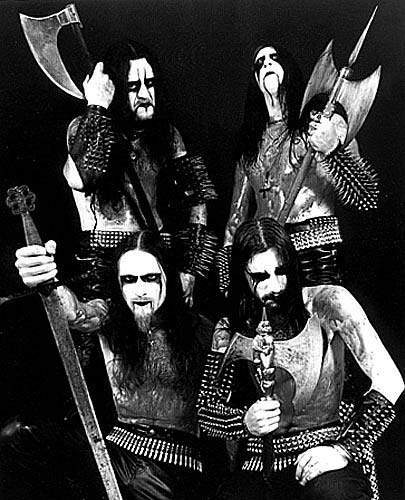
(Earlier this week, Metal Injection published a discourse on The 10 Most Lethal Weapons In Black Metal. In the introduction to the article, the author alluded to the reasons why certain kinds of weaponry have been associated with the genre. Now we get the author’s full explanation — a Part 1, if you will, to the Part 2 piece that appeared at Metal Injection. At NCS, you know the prolific author as Rev. Will. In the course of his research, he consulted members of Noctem, Sigh, and Edge of Paradise, as well as the Vegan Black Metal Chef.)
Funnily enough, whenever black metal weaponry floats to the surface of the perpetually random sea of thoughts slushing about in my head, the next thing that invariably comes to mind is the “bling-bling” of hip-hop culture. Before the elitists out there start coming down on me with the wrath of Satan’s cheeseburger, consider for a moment the following comparison.
Now, I am not insinuating that there is a musical similarity between both genres. What I would like to point out is that just as bling-bling is the Statue of Liberty of hip-hop, black metal weaponry is very much an iconic part of black metal that serves as the first graphic reference for most people’s memory banks when they try to recollect what they can of the grim metal sub-genre (someone ought to give it a catchy name too, maybe “cling-clang”). Just as many hip-hop artistes are famous within the mainstream music circle for their overly-flashy jewelry, black metal musicians are infamous within the underground music community for their ostentatious weapons as well.
Over time, both sets of accessories have evolved from merely being elements of sub-genre attire into cultural movements of their own. Bling-bling and cling-clang are both usually made of metal, but that’s where the similarity between both cultural movements stops. Unsurprisingly, for a sub-genre and cultural movement as pessimistic and misanthropic as black metal, its proliferation in the early ‘90s even had the occasional political motive—something much of hip-hop has left far behind since its early days.
Kvltvre & Politiks
The most striking thing about black metal weaponry is how vehemently backwards it is made to look on purpose. From the very first promotional pictures of Varg Vikernes and Euronymous carrying a mace and oriental sword, respectively, all the way to that cheesy random black metal band you see in your Google image search of “cheesy random black metal band”, they all look like extras out of the film set of some ‘60s medieval war-themed black-and-white movie. The motivation behind such a defiantly regressive look can perhaps be traced all the way back to the Viking Age (which spanned from the late 8th Century to the 11th Century) and Old Norse mythology, stuff that came way before Swedish musician Quorthon’s influential Viking/black metal band, Bathory.
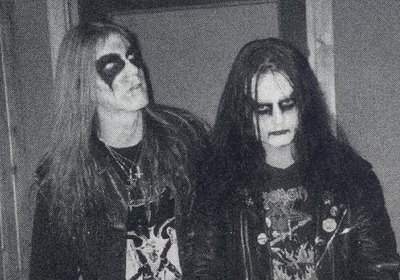
Dead and Euronymous
It is entirely possible that this whole cling-clang tradition of black metal culture simply began with Mayhem’s Euronymous and Dead wanting to replicate the look of dead people with their makeup as a form of artistic expression, and also posing with primitive weapons to possibly display their intense dislike for modern society and their desire to see mankind revert back to its less advanced state from many centuries before. While they might not have consciously noticed it or intended it to be so, such artistic expression on their part could possibly have been inspired by Bathory’s influential Viking metal albums (such as 1988’s Blood Fire Death and 1990’s Hammerheart); in addition, the fact that they had a strong hatred for Christianity—as evident from the church burnings they had helped to perpetrate—also possibly could have hinted at a subconscious fulfillment of ancient, Scandinavian pagan pride.
 In particular, the Christianization of Norway is a very touchy subject to many Norwegian black metal musicians, especially those within the early “True Norwegian Black Metal” scene; this is because Norse paganism was deemed to be the Devil’s work when the Anglo-Saxon Christian missionaries first discovered the existence of such a polytheistic, nature-based religion during their cultural invasion of Norway many centuries ago; as its fundamentals went against Christian teachings, the traditional Norse paganistic religion and its practices were eventually prohibited.
In particular, the Christianization of Norway is a very touchy subject to many Norwegian black metal musicians, especially those within the early “True Norwegian Black Metal” scene; this is because Norse paganism was deemed to be the Devil’s work when the Anglo-Saxon Christian missionaries first discovered the existence of such a polytheistic, nature-based religion during their cultural invasion of Norway many centuries ago; as its fundamentals went against Christian teachings, the traditional Norse paganistic religion and its practices were eventually prohibited.
Furthermore, the Christians successfully converted Olaf I of Norway (King of Norway from 995 to 1000 AD) as well, and with it Christianity’s influence in Norway started gaining headway from 1000 AD onwards, and the rest is history. Norway is one of the world’s most Christian countries today, with 83.6% of its population identifying themselves as Christians as of 2011. That history naturally ignited the desire within a minority of the population to revive their indigenous Norse pagan religion and regain their lost roots.
While most people under the rule of a supreme leader have a general tendency to behave like sheep and follow in his footsteps, it is human nature that some will chafe at such an idea and rebelliously stick to their indigenous culture and its inherent paganistic beliefs. Christianity introduced Anglo-Saxon cultural traditions into Norway, such as burying the dead without any worldly possessions; in contrast, followers of Norwegian paganism buried the dead with worldly possessions to accompany them into the afterlife. Even most modern humans instinctively resist sudden, cultural changes, so why should adherents of Norse culture have been any different?
Since the Vikings were versatile warriors-cum-explorers who were revered by Scandinavians as a combative and fearless/fearsome bunch of folks, their weapons naturally became synonymous with their frightening fighting capabilities, possibly implanting in the subconscious minds of a minority of posterity the idea that Viking weapons are powerful symbols of lost Scandinavian pagan pride. To be more concrete with this theory, a non-Scandinavian example is needed.
Case in point: Native Americans initially rejected the imposed cultures and religions of their European colonizers because they valued their own traditions and gods (which had been under their own “ownership” for thousands of years); and when Europeans and their descendants decided to subdue them through the use of force, Native Americans bravely but futilely fought back with their primitive weapons, even though many probably realized that they were fighting a losing battle right from the beginning.
To sum things up, there hasn’t been, and probably will never be, such a thing as 100% cultural assimilation. History has proven time and time again that not everyone is willing to give up his or her cultural identity for someone else’s.
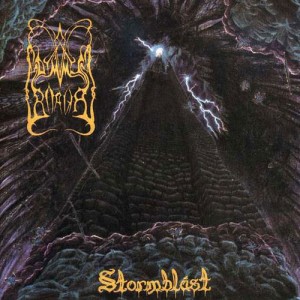 To a lesser and not-so-obvious extent, political motives have occasionally been extensions of the cultural motives behind utilizing black metal weaponry. The clearest example would be Norwegian symphonic black metal band, Dimmu Borgir, who spent their early days singing their recorded songs purely in Norwegian (1996’s Stormblåst was their second and last studio album to do that). That in itself was a very political thing to do, for the album was released in an era when black metal was just beginning to proliferate. As such, it could possibly have been the band’s way of sending out the message to the global extreme metal community that they would have to pick up Norwegian and familiarize themselves with Norwegian culture if they wanted to understand whatever shit the band was going on about.
To a lesser and not-so-obvious extent, political motives have occasionally been extensions of the cultural motives behind utilizing black metal weaponry. The clearest example would be Norwegian symphonic black metal band, Dimmu Borgir, who spent their early days singing their recorded songs purely in Norwegian (1996’s Stormblåst was their second and last studio album to do that). That in itself was a very political thing to do, for the album was released in an era when black metal was just beginning to proliferate. As such, it could possibly have been the band’s way of sending out the message to the global extreme metal community that they would have to pick up Norwegian and familiarize themselves with Norwegian culture if they wanted to understand whatever shit the band was going on about.
Even when Dimmu Borgir later started to write and sing their songs in English, a move that I speculate was largely financially motivated, it could still have been a politically motivated move, because it allowed the band to convey their previously exclusive lyrical subject matter to a wider audience (and hence help spread their brand of Norwegian paganistic/Satanic/anti-Christian ideas to more people).
Of course, many other black metal bands—especially the supposedly NSBM ones—come to mind when touching on the topic of political motives in black metal music, but since many of them, such as Marduk and Taake, deny any such political motives in their music, it’s difficult to use them as evidence relevant to this aspect of black metal weaponry, unless you consider speculation to be the equal of fact. The one and only clear example I can think of is Germany’s Absurd, a band so extreme in, and open about, their political views that they can practically stand as the archetypes for German Nazi black metal groups.
Artistic Expression
Expanding upon a simpler reason touched on earlier, it is plausible that black metal weaponry is just used as a form of artistic expression, plain and simple. Nothing more complicated than that. Exo of Spanish blackened death metal band, Noctem, certainly doesn’t see black metal weaponry as having any complicated implications behind it, and ponders if it could be serving no purpose other than making the band in question look badass.
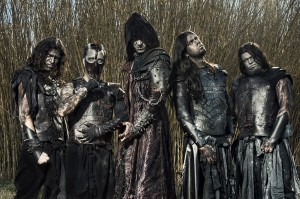
Noctem
“I think it is something that gives a band a tough appearance, but only if they know how to use it appropriately, because in black metal there’s a lot of humor with this, you know, Immortal videos etc. For me it is not like that, we use our performance to express something. It is a “driver” of the music. I can’t imagine myself wearing a random T-shirt and a pair of trousers playing our songs at a show.”
Indeed, the newer generation of black metal bands generally seem to be wielding black metal weaponry more for the sake of following musical tradition — that was how it had always been with the bands they listened to in their formative years! Varg Vikernes of Burzum even stated so in an interview with Metal Injection, asserting that “modern black metal is a parody of what black metal was in 1992”. But what about those black metal bands who started out during that era and who have reinvented themselves countless times over the years? What does black metal weaponry mean to them after all these years?
 “The first metal band photo with a weapon was Venom‘s one as far as I recall,” recounts Mirai Kawashima of Japan’s Sigh. “On the back cover of Welcome To Hell, Mantas was holding a small axe. There might have been other metal bands with weapons before then, but that photo was the first one I came across when I was young and thought really cool. Venom‘s image has been a huge impact on black metal bands whether you’re from Europe or from Asia.”
“The first metal band photo with a weapon was Venom‘s one as far as I recall,” recounts Mirai Kawashima of Japan’s Sigh. “On the back cover of Welcome To Hell, Mantas was holding a small axe. There might have been other metal bands with weapons before then, but that photo was the first one I came across when I was young and thought really cool. Venom‘s image has been a huge impact on black metal bands whether you’re from Europe or from Asia.”
He continues: “Euronymous’ [of Mayhem] classic photo with a saber and Burzum‘s one with a cobra knife or a mace-like one certainly consolidated the image of black metal during the ‘90s. Although we used a Japanese sword in our photos, I really do not think there’s a huge difference between Scandinavian bands and Asian ones for this kind of imagery. As Mantas [of Venom] seemed to have been into Asian martial arts, he often used some oriental weapons, too. Weapons are now almost as common as long hair and leather jackets in metal photos. Now, nobody asks why you wear leather jackets or leave long hair anymore because obviously, they suit the image of metal perfectly—and this is the same for weapons. These images are almost the same everywhere; be it Europe, North America, Latin America, Asia or wherever. Metal is evil. Metal is a fantasy. Metal is a rebellion. That’s what weapons stand for [in black metal] in my opinion.”
Then of course, there are those black metal younglings who take the idea of black metal weaponry really literally to indulge in their violent fantasies.

“What are you talking about? Black metal weaponry will smite the weakling foes from this wretched Earth. They are the pure implements of Satan forged in the fiery depths of Hell. Even the might of nations cowers before a spiked mace… Just for fun, I took the entire state of Florida hostage the other day with nothing but an axe and some sweet spiked armbands… They didn’t want none of this shit,” boasts Brian Manowitz a/k/a the Vegan Black Metal Chef.
The Mojo Factor
One crazy thought that hit me while conducting research about this topic is the possibility that hormones played a part in creating the incentive to wield black metal weaponry in the first place. We all know from scientific research that hormones play a vital role in compelling social interaction. Could it be, then, that male black metal musicians in general are actually subconsciously wielding weapons as a form of mojo boost to increase their chances of encountering and attracting a consenting partner?
Metal in general has always had a reputation for its testosterone-crazed fashion and culture (e.g., ripped jeans, leather, long and shaggy manes, hard-drinking lifestyles). Since many black metal musicians at least outwardly appear to be socially awkward introverts desiring to be different from the masses yet wanting to gain acceptance within their own circles at the same time, could black metal weaponry be their extreme alternative to the more prevalent metal norms for appearing attractive to members of the opposite sex? The thought is certainly intriguing (and amusing), but even if it were true, the gals might not find the tactic to be working in the guys’ favor.
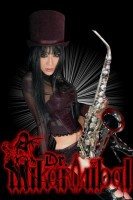 “I suppose they [male black metal musicians] naturally felt that it was cool to pose with those items when they first started, and not because they were trying to fake anything,” the attractive Dr. Mikannibal of Sigh suggests. “For me, items for [black metal] posing have to be blood, fire, snakes, and being half-naked [Note: She means guys only!], while tight clothing, lip piercings, and stupid asymmetric haircuts are for emo guys. So, this style [of wielding weapons] is probably based on their musical interest, i.e. what they grew up listening to, and also how they grew up, how they spent their youths, and mostly what kind of cultural backgrounds they have as well.”
“I suppose they [male black metal musicians] naturally felt that it was cool to pose with those items when they first started, and not because they were trying to fake anything,” the attractive Dr. Mikannibal of Sigh suggests. “For me, items for [black metal] posing have to be blood, fire, snakes, and being half-naked [Note: She means guys only!], while tight clothing, lip piercings, and stupid asymmetric haircuts are for emo guys. So, this style [of wielding weapons] is probably based on their musical interest, i.e. what they grew up listening to, and also how they grew up, how they spent their youths, and mostly what kind of cultural backgrounds they have as well.”
Dr. Mikannibal cruelly proceeds to deliver the harsh truth: “Anyway, posing with weapons doesn’t look macho at all. Somehow, it gives me an impression that they are so ‘pure’.”
 For the sake of diversity, I decided to consult a non-black metal female musician for her views on this matter as well. Margarita Monet of Los Angeles-based heavy metal band, Edge Of Paradise, thinks otherwise though. Her main gripe, however, is how hard it is for black metal guys to look tough instead of cheesy. The sizzling hot chick explains, “Since the [male] black metal musicians are posing with such weapons, it conveys more of an aggressive image to me. But it’s a very fine line between badass and corny, and I salute those few musicians who achieve a badass image.”
For the sake of diversity, I decided to consult a non-black metal female musician for her views on this matter as well. Margarita Monet of Los Angeles-based heavy metal band, Edge Of Paradise, thinks otherwise though. Her main gripe, however, is how hard it is for black metal guys to look tough instead of cheesy. The sizzling hot chick explains, “Since the [male] black metal musicians are posing with such weapons, it conveys more of an aggressive image to me. But it’s a very fine line between badass and corny, and I salute those few musicians who achieve a badass image.”
Word, Margarita.

I thought big swords were like big pick-ups: indicative of something….smaller.
You mean the mojo?
And do you mean big swords like this?
http://media.animevice.com/uploads/0/69/440239-fairy_tail___87__30__super.jpg
Holy fuck, if that guy’s not compensating, then I don’t masturbate in public.
And we all know I masturbate in public–especially at the aquarium.
AND WITH THE NCS SHIRT! You just gotta have to wear it while you masturbate in public, you know, just so to emphasize on the whole stunt.
And to get publicity for the site, of course!!!
How much would it cost to get you to burn the shirt?
Ummmm… Two more shirts and a picture of your peepee.
Could I interest you instead in a bottle of bleach, a jar of cocktail olives, and what I just scooped out of my cat’s litter box?
Wait, Islander has a pee pee? Since when did Skynet implement the Cyborg Reproductivity Bill in Terminator Congress?
*pass the Cyborg Reproductivity Bill
Please stop talking about my pee pee.
Best Black Metal weapon . . . gotta be the poisoned crunk-cup chalice of death here…
http://www.youtube.com/watch?v=hetxbv0w10o&hd=1